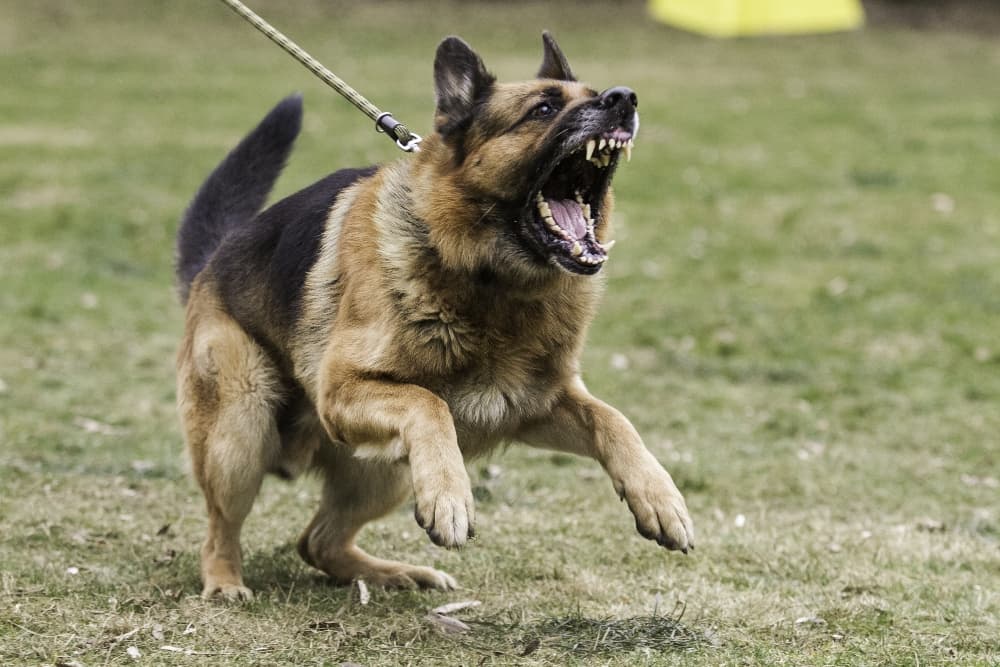
It can be nerve-wracking and embarrassing to have to drag your dog away kicking and screaming whenever you pass another pup on your walk. Leash aggression in dogs is very common, but fortunately, you can teach your dog a better way.
Nothing can ruin an otherwise pleasurable walk with your dog like their sudden, often unpredictable fear and aggression, especially when meeting other dogs along the way. Learn how to spot leash aggression, how to train and desensitize your reactive dog, and tips for socializing leash reactive dogs.
To get you the most accurate and helpful information, we connected with Kris Hampton, BA (Hons), CPDT-KA, the founder and lead trainer at Raintown Dog Training.
What is a Leash Reactive Dog?
We’ve all been there—enjoying a relaxing stroll along your favourite walking path with your dog in tow, when suddenly, your typically calm and reserved dog spots another dog that is headed your way and begins lashing out angrily.
If your dog typically enjoys walking alongside you, with or without a leash, and shows no issues when socializing with other dogs, she is probably not a reactive dog. If, however, you notice that your usually playful pup becomes aggressive and challenging when leashed around other dogs, it’s important to take note.
A leash-aggressive dog, or leash-reactive dog, will show some common behaviours when leashed and meeting other dogs, such as:
-
- Lunging toward another dog, jaws open and/or teeth bared
- Attempting to tear off their collar or bite at their leash
- Nervous barking or growling
- Intentionally standing between you and the other dog in a protective stance
Unfortunately, the more leash aggressive your dog is, the less likely you are to be interested in taking him on walks. This, in turn, leads to fewer and fewer opportunities for your dog to socialize with other dogs, creating a self-fulfilling prophecy every time you attempt to take him out on the leash.
Why Is My Dog So Leash Aggressive?
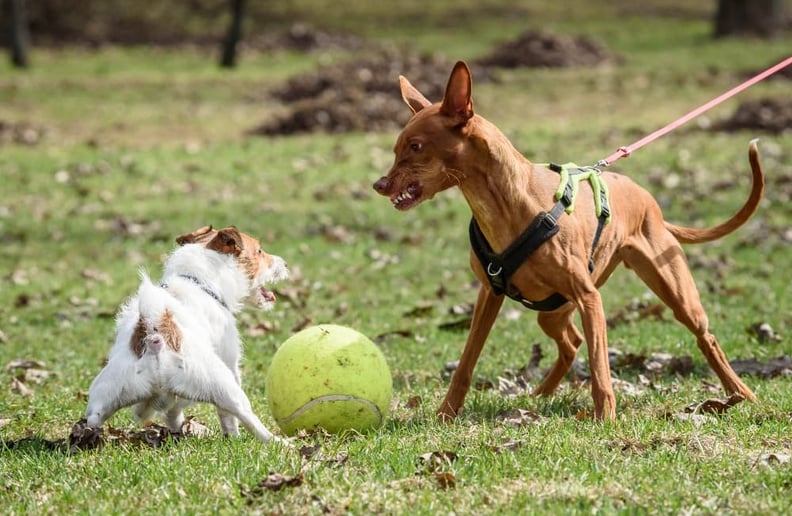
But you may be wondering - why is my dog so leash aggressive in the first place? Sometimes we experience dog aggression on leash, but their reactive behaviours are amazing off-leash! This is super common when dealing with leash aggression in dogs. Why is my dog aggressive to other dogs on walks?
Other owners notice their dogs becoming aggressive on leash as they grow older. And as that popular saying suggests: “Can’t teach an old dog new tricks!” this can feel extra concerning.
But don’t let this belief discourage you. Leash aggression training can be a success for any dog at any life stage!
Unless a dog has been properly trained or has naturally learned how to greet and treat other dogs as a puppy—by being disciplined via short barking alerts given by older dogs—he may not know how to appropriately greet and interact with other dogs.
If your dog gets his doggy panties in a bunch when another dog or a person approaches when he's attached to a leash, then you need to start your training by understanding why your dog is reactive this way.
Fear and Frustration
Leash aggression and leash reactive dog behaviours result from your dog feeling threatened by the proximity of another dog and being trapped in that space, unable to escape and keep a more comfortable space between herself and other dogs.
Likewise, some dogs become leash aggressive because their leash prevents them from interacting in a more natural way with other dogs, making them frustrated and causing them to lunge, bark, or growl to express this frustration.
In other words, your dog is most likely acting aggressively when leashed either because he is frustrated by his inability to naturally greet other dogs (and humans!), or because he is afraid and has no other choice but to defend himself from a perceived threat.
When dogs meet one another in the wild, they would naturally turn their bodies to the side rather than approaching one another head-on. They would also avoid direct eye contact and instead get to work sniffing out identifying information from one another’s genital areas.
But when walking your dog on a leash, she is forced to interact with a new dog in an unnatural and threatening way, making her feel vulnerable and anxious to protect you, her owner and companion.
By forcing dogs to meet one another head-on, we are sending a signal that we want them to fight one another—a signal that is especially strong because dogs are naturally territorial and loyal to their owners.
Increased Anxiety
As a dog mom or dad, you are always worried about keeping your pet safe, and this could lead to some anxiety when you take your dog out into unfamiliar situations. Your dog picks up on your emotions, so if you are nervous approaching another dog while your dog is on-leash, then you increase the likelihood of your dog feeling nervous too.
This increased circuit of anxiety—which then is also transferred between the two of you and the other dog and dog owner—creates a cycle of reactivity and tension in both you and your dog, which cannot easily be dissipated.
Furthermore, you can't always control your anxiety, especially if your dog has a history of leash reactivity. This means that both you and your dog need some training.
If you already know that your pooch is leash reactive, you may be hesitant to take her to high foot traffic areas, which in turn, only perpetuates these inappropriate reactive behaviours. You may begin to feel like you'll never break this cycle, but don't give up yet. Dog training leash aggression in dogs can be cured!
Dangers of Leash Aggressive Dogs
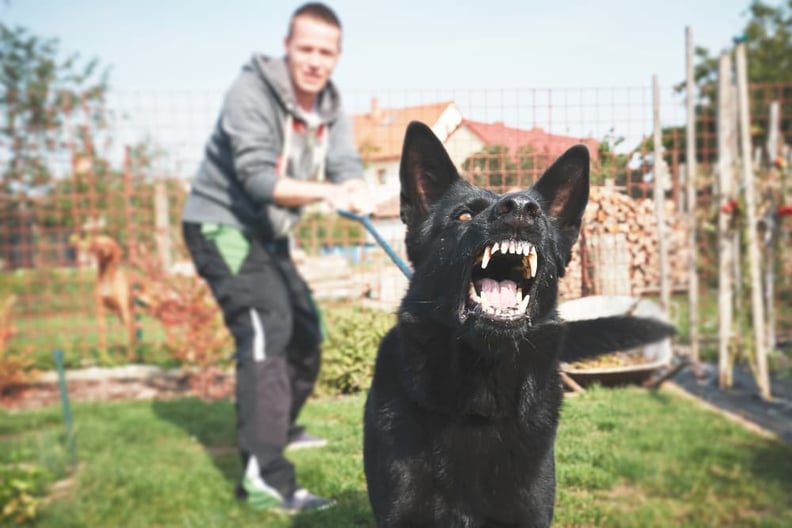
Anyone can see that leash reactive behaviours in dogs are not good, but curbing this bad behaviour is about more than just the ease of walking your dog. Persistent leash aggression can lead to long-term issues that may be permanent if you don't act now.
Here are a few situations that may develop if you aren't careful about training your dog to ditch his leash aggression tendencies:
Anxiety
If you don't do anything to help your dog to get past his fearful, territorial, or aggressive habits, it could lead to further anxiety. By allowing the behaviours, or worse, punishing them, you may be creating a negative association with meeting new dogs and people, or even exploring new environments.
Stigma
Eventually, your neighbours, friends, and other dog owners are going to label your dog as an aggressive jerk. This raises everyone's anxieties, which your dog will pick up on. Being the neighbourhood pariah will not help your dog build confidence, nor will it help you build confidence in your dog.
Loneliness
Dogs need friends of their own size and species. Most dogs can benefit greatly and learn a lot from interacting positively with other dogs.
When properly socialized, having dog friends can enrich your dog's playtime, provide mental stimulation that tuckers him out, and help to teach him better behaviours. He may never be the social butterfly that you'd like him to be, but having one or two dog friends can help.
Injury
Your dog may feel tough when he's acting like a bully to other dogs, but eventually, he could come across a bigger, badder dog that is having none of his 'tude. His usual doggy mouthing off may trigger another dog to attack, or defend, leading to serious injuries to your dog or even you!
This is especially important to keep in mind if you already have trouble controlling your dog. If your dog is bigger or stronger than you, you may not have a choice but to get involved to break up a dog fight.
Legal Consequences
The last danger of allowing your dog to continue his reactive behaviours on a leash is also the worst-case scenario. What happens if your dog attacks another dog or a person. Even small dogs have the ability to cause significant damage if they feel they're fighting for their life.
The last thing you want is for someone to get hurt and to be on the hook for damages, legal consequences, or worse - your dog being branded as aggressive and being put down for something that really isn't his fault.
If your dog is on the receiving end of an aggressive dog, then you need to learn not only what to do, but also know how to prevent these negative interactions. Be respectful of other dogs' boundaries, and keep your dog in check, no matter how well-trained and friendly they are.
If your dog has good recall, he may be used to walking off-leash, but this also means that he may get too close to a leash aggressive dog and get himself in a pickle.
How to Train A Reactive Dog On Leash
How to socialize a reactive dog? How to train a reactive dog on leash? When it comes to training a leash reactive dog, the first thing to remember is patience. Like with any type of training, it takes time. So don’t give up, and don’t feel discouraged if your doggo seems to be reluctant to the process.
Follow these helpful tips for leash reactive dog training:
1. Train Yourself First
The first step to handling your leash aggressive dog is training yourself to spot your dog’s body language and respond appropriately before things get out of hand. Many dogs (but not all dogs!) show several warning signs that they are reaching their threshold, including:
-
- Hard Eye. In some dogs, a hard stare is the only sign they are about to snap or bite, so it’s crucial to know how to spot this to avoid injury. A hard eye is an oblique threat, and it might involve the exposure of the whites of your dog’s eyes (also known as ‘whale eye’) or dilated pupils. You might see it in conjunction with various ear positions and/or teeth displays.
- A stiff, waxy body. Your dog might freeze and become immobile when things are about to go from fun interactions to dangerous altercations. Remember, being still is not the same as being calm.
- Raised Hackles. Also known as piloerection, when the hair stands up on your dog’s neck, it could mean they are trying to make themselves look bigger to ward off a perceived threat.
- Pinned ears. When your dog feels threatened by another dog, his ears might be pinned back to indicate that they are fearful or to try to appease the other dog
- Curled lips, bared teeth. If you see your dog start to curl his lips across his bared upper teeth, otherwise called a snarl, things have become more serious.
- Tucked tail. Like pinned ears, your dog’s tucked tail is often a surefire indicator that she feels afraid or threatened and wishes to escape her current surroundings, which could instigate leash aggression.
- Low growl. Another indicator of your dog’s feelings is the sound he makes when feeling threatened or irritated by another dog. The low snarl or growl is a clear warning sign that this situation could escalate to an attack or altercation.
- Tongue Flicks. A flicking ‘lizard’ tongue outside of greeting settings is often used by dogs to inhibit aggression in other animals.
Learning how to detect your dog’s warning signs requires studying your dog closely when they do interact with other dogs. It may also help to hire a dog trainer who can teach you how to interpret both your dog’s body language and vocal alerts, as well as those of other dogs.
Recognizing his ways of alerting other dogs to his increased anxiety will better enable you to help your leash reactive dog feel less afraid or intimidated. Find out more about what your dog is non-verbally telling you in How to Read and Understand Your Dog's Body Langauge.
Beware of Over Interpretation!
It’s important to take in the entire picture of what’s happening in your dog’s body and environment before assuming they are upset or about to aggress, warns Kris. Remember also that there is ambivalence with the threat at times - humans have mixed bags of emotions all the time, and dogs are no different. If you overreact to the situation, you increase the chances that your dog will follow your example.
2. Make Sure It’s Not Something More Serious
Sometimes, your dog’s leash reactivity and leash aggression may have little to do with the leash itself—something you could spot by watching your dog interacting with other dogs, even when off the leash.
Perhaps there is a medical explanation for his reactivity. If your dog is feeling unwell or has an underlying medical condition, he is especially vulnerable to attack from other dogs, increasing his anxiety, leash or no leash.
If this is something you’ve noticed, the first step would be to seek out a veterinarian who could do a full exam to ensure your dog's health.
In other cases, your otherwise healthy dog may be lashing out at other dogs when leashed because of an underlying mental or emotional issue she is struggling through—a problem especially prominent among rescued dogs whose past may have included abuse or abandonment.
Even in cases such as these, there are ways to help train your leash aggressive pup to be less combative when meeting other dogs.
3. Treats are a Dog’s Best Friend
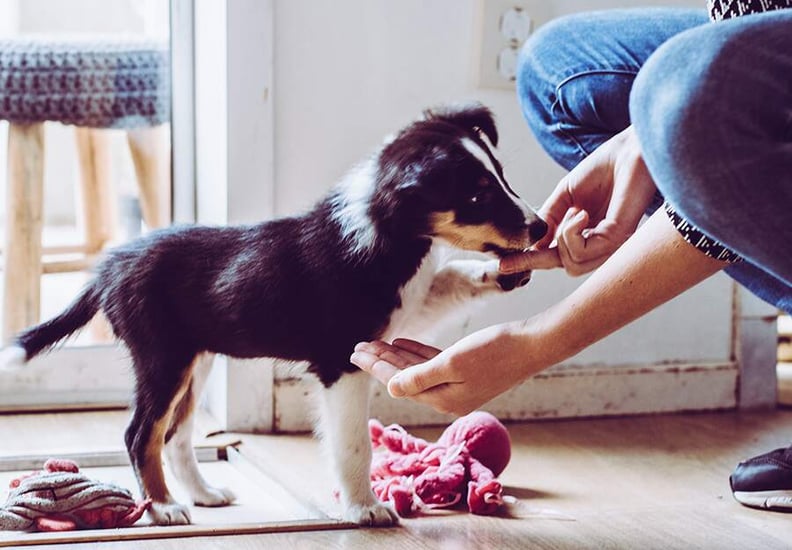
Who doesn’t love treats? Treats are a dog’s best friend and will soon become yours, too. If we want to change our dog’s emotional response from fear to happy anticipation, pairing the scary stimulus (in this case, other dogs on walks) with a mouth-watering treat will create a positive association with other dogs on walks.
When you’re ready to take your dog out for a walk, make sure to keep a pack of your doggo’s favourite treats on hand. When, on your walk, you spot another dog from a distance (a distance that is large enough that your dog is not reacting to them already), begin happily talking to your pup and start a flow of delicious treats. Once the other dog is out of sight, stop the treat flow. Repeat this with other dogs throughout your walk (making sure that your dog sees them but that they are far enough away that your dog is comfortable).
In time, your pup will realize that seeing other dogs on walks leads to a tasty food party, and who doesn’t love a food party? Now we love spotting other dogs on walks!
Remember this simple formula for ‘counter-conditioning’ your reactive dog:
-
- See a new dog approaching
- Offer him a huge, yummy treat or his favourite toy
- Continue offering treats and/or playtime with you and his toy so long as the other dog is within his sight
- Stop offering treats as soon as the other dog is out of sight
Using this classical conditioning technique on your dog will train him to begin to perceive the presence of another dog as a sign that good things are coming his way—in the form of treats, belly rubs, play, and his favourite toys.
He will also learn to keep his attention on you (and your treat pouch!) when other dogs are near, keeping you in the driver’s seat and him at bay.
4. Be Mindful of Lapses in Behaviour
Remember: punishing your dog only increases his anxiety. While you shouldn’t reward your dog for negative behaviour, never punish your dog for having a lapse in positive behaviour.
This is because your dog will start to associate the negative punishment with the experience of meeting another dog, making him even more unlikely to act appropriately around other dogs.
The best response when your dog has lapses in leash reactivity is to stay cool, calm, and collected and to get your pup out of dodge. Then think about ways you can manage your dog’s environment to prevent them from repeating the reactive behaviour. Do you need to increase the distance between your dog and other dogs? Do you need to avoid busy areas? Do you need to hire a professional dog trainer to work with you on modifying their behaviour?
5. Try Leash Reactivity Gear
Perhaps you need a little extra help when you’re first starting out and learning how to stop leash aggression. This is where leash reactivity tools come in real handy.
A muzzle is a highly effective tool for a reactive dog, especially useful if dealing with leash-biting aggression or if you feel your dog’s anxiety could get you both into some serious trouble.
A muzzle is similar to a mask that fits around your dog’s snout with a strap that goes up over the head and another around the neck. It is designed with open spaces so your dog can pant, drink water, and even accept treats.
A head halter for reactive dogs is a special type of collar with two straps: one that is secured around the snout and another around the neck, just behind the ears. This provides more control of your dog’s movements and helps you direct your dog in the direction you’d like them to walk.
How to Get Your Dog Comfortable with Reactivity Gear
You don't want your dog to see the gear as a punishment, so like any other training tool, try to make sure you associate it with a positive reward like treats. Here are some tips for getting them used to their new headgear:
-
- Introduce the tools just before offering constant small treats (as small as possible, so you can feed many at a time). The timing here is key as the tool has to be shown or strapped on before the treat
- Practice putting in on and taking it off, rewarding constantly. Take small slow steps to allow your dog to acclimate.
- It will take time for them to get used to the feeling of having something with a little more restriction on their heads, and with continued training sessions, these tools will become less and less necessary.
- It’s important to never jerk your dog’s head around to prevent injury while wearing them. You risk injuring their neck, scaring them, or associating the reactivity gear with a punishment.
- When you are comfortable enough to stop using the muzzle or head halter, it's still a good idea to bring it with you, just in case. It's one of those things that are better to have and not need than the other way around.
6. Treat Anxiety
If you have a generally fearful dog, then it can be helpful to try to naturally or medically treat the anxiety that causes the flight or fight reactions you see when your dog is approached by a stranger or another pet.
This will not be a complete cure, but it can be a helpful part of your dog's leash reactivity training session.
Less invasive methods are generally recommended to start, so consider trying a Thundershirt on your dog before you jump to medications. Thundershirts are basically compression vest that helps your dog feel the same kind of natural protection and safety that a swaddled baby would feel.
Thundershirts can sometimes have the added benefit of a pheromone patch near the chest and shoulder area that offers a synthetic pheromone that mimics the natural pheromone that mother dogs release to calm their puppies.
To learn more about managing anxiety in your pooch, check out our Guide to Dealing with Dog Anxiety.
7. Protect Your Canine Friend
When attempting to teach your reactive dog to be less leash aggressive, it’s important to create a safe space for him, wherever the two of you go. This means not allowing others to approach or greet him or come too close to him or get in his face.
Don't be afraid to tell an approaching stranger that your dog is still practicing his manners and shouldn't be approached. Not everyone has the common courtesy of asking before they approach, especially if they have a friendly and well-socialized dog.
It also means ensuring that any interactions he may have with other dogs are in an environment that is free of loud noises and other sensory experiences which may contribute to how overwhelming it is, adding to his already heightened anxiety.
8. Socialize Your Dog
While your dog may be reactive on leash, he may have no issues interacting with dogs when he's set loose. This could be at a dog park, in your backyard, or even just in your living room with a friend or neighbour's doggo.
The more practice your dog gets at socializing with other dogs, the easier it will be for him to be less fearful or on guard when you are walking on a leash.
Socializing is best to start young, but dogs of any age can make new friends and learn how to react appropriately when an outgoing or hyper pooch runs up to say hello.
What to Do if An Off-Leash Dog Approaches You While Walking Your Dog
Even if you take all the right steps to avoid a bad situation, your dog can still get into trouble if approached in the wrong way. It's not uncommon for an off-leash dog to approach a dog on lead.
While the intention of the approaching dog is typically playful or friendly, your dog may still take offense to this intrusive interaction.
This can be challenging because you have limited control over the other dog's actions, and you don't know how defensively they may react to your dog's abrupt change in attitude.
Here are a few tips for keeping you and your dog safe in the event that he is approached by a loose dog:
1. Lead your dog away quickly if you see the dog approaching.
This will change your dog's focus away and put some distance between your dog and the other dog. Try to avoid dragging your dog as the leash tension will frustrate them, below are two pointers on how to avoid pulling your dog when retreating from an incoming off-leash dog:
-
-
- Kris recommends trying a hand kong! Make a ‘kong’ out of your hand by enclosing yummy treats in it and holding your closed fistful of treats near your dog’s nose. Your dog will follow the yummy scent of your hand as you turn and lead her away from the trigger.
- Try ‘find it!’. Say ‘find it!’ and toss a handful of treats on the ground behind your dog, away from the oncoming dog. Once your dog has turned away from the trigger, you can use your happy voice and trot away from the other dog to encourage your dog to follow you.
-
2. If you can't get away, try to put a physical or visual barrier, like a wall, fence, or car between the dogs. This isn't always possible in an open space, but this can help calm tensions.
3. Talk to the owner of the other dog if possible. Even if they are far away, you need to get their attention and ask them to call their dog away. Wave your arms, whistle, and yell (as calmly as possible) if you have to, but they need to know that their dog is getting too close to your dog.
Learn more about what to do If your dog gets approached by an off-leash dog so that you can make sure your dog has a positive walking experience.
Ways to Socialize Your Dog
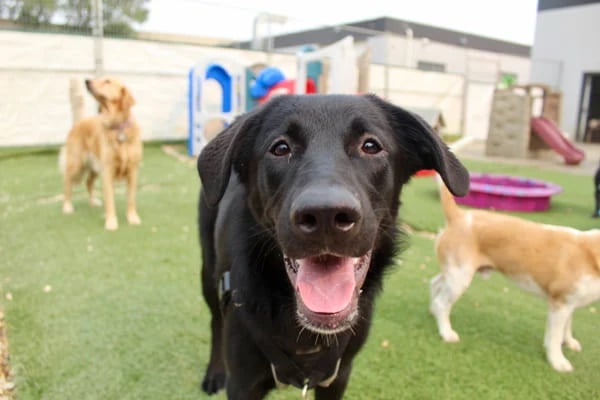
How you socialize your dog will greatly depend on how nervous or aggressive your dog is. If he's only usually aggressive on leash, then there are many ways to help him interact with other dogs in a friendly and controlled environment.
Unleash the Doggos!
Believe it or not, the most effective way to train a leash reactive dog is by giving her opportunities for leash-free doggy interaction—in a safe space.
Once you have established that your dog is medically and emotionally well and you’ve begun teaching him to focus his attention on you when meeting a new dog, it’s time to work on giving your pup opportunities to engage with other dogs in a way that feels more natural for him.
This means making a concerted effort to socialize them more, much as you’d like to keep them home and far away from opportunities for leash aggression.
Doggy daycare is another great way to allow your dog to play with his own kind. Find out more in the Benefits of Dog Daycare.
Recruit Help
The best way to begin socializing your leash reactive pup is by bringing him around calmer, trained dogs who do not have this issue with leash aggression. Dogs learn quickest and easiest from other dogs, so find a well-trained doggy friend and set up some play dates.
To begin, place both dogs far enough away from one another in a large enough space that both feel comfortable and are not caged in.
Bring out the toys and treats you know she loves and begin playing with her, keeping her distracted from the other dog across the way.
Observe your dog. If he is calm and playful, ask your friend or neighbour to bring their dog just a bit closer to yours, and again, keep your dog distracted with play and treats.
Continue this game until your dog shows signs of leash reactivity. Once this happens, simply walk away from the other dog and put more space between them and the other dog. Don’t offer treats or play until he has calmed down, and start the process again.
Eventually, your dog and the other dog will become ready to engage with one another in a calm and non-aggressive way. Remember: if, at any time, your dog shows signs of aggression, simply remove him from the situation.
Do not hit or punish him in any way, as this will just serve to reinforce his association with meeting other dogs and feeling threatened or in pain.
Talk to a Professional
Every dog can have their own specific triggers and reactions. If your dog is generally less than enthused about other dogs, even off-leash, then you will need to take a careful and thorough approach to change his behaviours and fears. We highly recommend connecting with a certified, force-free and positive reinforcement-based trainer like Raintown Dog training session.
Raintown Dog Training exists to empower dog-parents with inspiration, skills and knowledge to build mutual confidence within dog-parent relationships and create a shared sense of community amongst Vancouver’s dog-lovers.
We value knowledge, growth, authenticity, shared joy, and fun! At Raintown, we work alongside dog parents to provide education, demonstrations and coaching to build their training skills in both private and group settings - says Founder Kris Hampton.
Best Leash for Aggressive Dogs
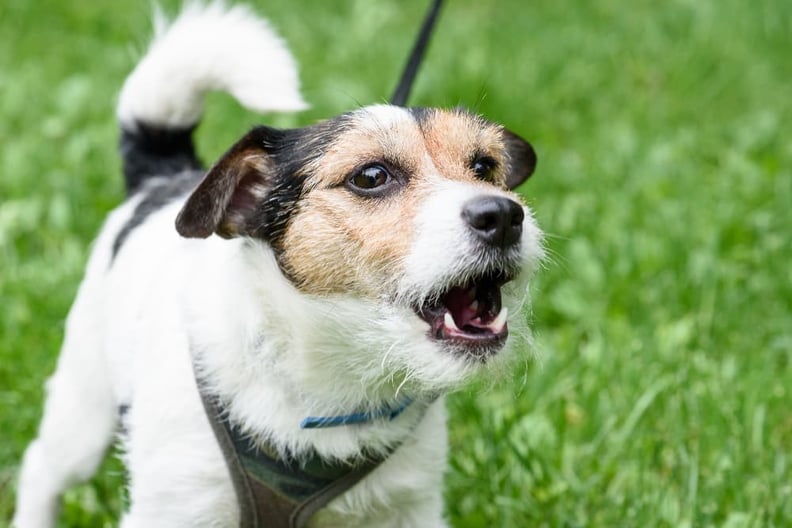
When learning how to deal with leash reactive dogs or leash aggressive dogs, the type of leash you use is essential. You need something sturdy, durable, and on the shorter side to keep your dog close and maintain full control.
Avoid using a retractable leash at all costs. They aren’t very strong and could easily snap if your dog takes off running full speed ahead. Additionally, they give your dog too much space and give you less control over their movements.
The best leashes for aggressive dogs are made out of thick nylon or leather. Both of these materials are tough, just like your pup!
Length matters too! We already said that retractable leashes are not good for this situation, but long leads, like those for recall training, also offer too much space and not enough control.
Stick to 6ft or under. This keeps your dog close enough that you can reach down and grab their collar or pick them up if absolutely needed.
Here are some of our recommendations:
-
- Rogz Reflective Leash - Rogz makes a durable and lightweight leash made of nylon webbing and reflective stitching that can stand up to strong pullers.
- Ruffwear Front Range Dog Leash - This soft and comfortable leash is made with polyester webbing that is tough and lightweight. The added traffic control handle is great for gaining quick control of your dog in a tense situation.
- Multipet Leash Wraps - A good way to help make interactions with humans and their pets easier is to use a leash wrap to let people know that your dog may not want to make friends.
Make sure you have a sturdy and reliable collar too. Collars are your last option for getting a close, strong grip on your dog if your leash should fail. Try our dog collar selector to find the right one for your pooch.
A harness may be the safest option if your dog is too tough or pulls too much to rely on a collar for control. Choosing the Best Dog Harness will depend on your dog's habits and usual activities.
Keep It Paws-itive
Your dog wants to play and socialize with other dogs, just as you want to socialize with other humans, but in many cases, they just haven't been taught how. Teaching your dog good walking behaviours, like loose-leash walking or recall training for dogs, can contribute to your dog's confidence on leash and around other animals and people.
Practice makes perfect, so don't be discouraged if you don't see immediate progress. With patience, a calm and carefree attitude, and a commitment to giving both your dog and yourself more peace of mind, you can train your reactive dog to be more relaxed, playful, and less aggressive, using positive reinforcement to keep his attention on you. You will also be giving him opportunities to interact with other dogs safely on and off leash.
Using this method, you’ll have effectively socialized your leash-aggressive dog, giving everyone—and every dog!—a more positive experience.
Frequently Asked Questions About Reactive Dogs
What is leash aggression in dogs?
Leash aggression refers to a dog displaying aggressive or reactive behaviour while on a leash, such as barking, growling, or lunging toward other dogs or people.
What are the common causes of leash aggression in dogs?
Leash aggression can stem from fear, frustration, territorial behaviour, or a lack of socialization. Getting to the root cause of the problem is necessary to solve it.
How can I prevent leash aggression in my dog?
Preventing leash aggression involves proper socialization, positive reinforcement training, and using a leash and harness that allows better control. Avoid tense or confrontational situations during walks.
What are some training techniques for overcoming leash aggression?
Training techniques may include desensitization and counter-conditioning, where the dog is slowly exposed to triggers in a controlled, positive manner.
Are there specific tools or equipment that can help manage leash aggression?
Tools like front-clip harnesses or head halters can provide better control during walks, but these tools do require some positive reinforcement training to adjust to them.
How long does it typically take to overcome leash aggression in dogs?
Some dogs may show improvement in weeks, while others may take several months or longer to make progress.
.png?width=200&height=66&name=logo%20(1).png)



